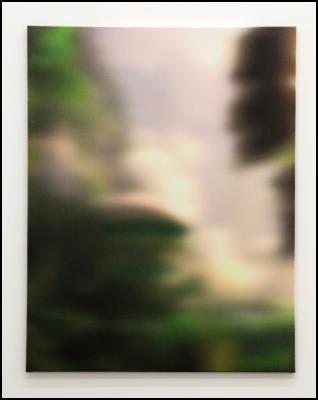David Bradley - Powershot: 1 to 25 March, 2017
Bowerbank Ninow presents Ry David Bradley -
Powershot: 1 to 25 March, 2017
In The Principle of Hope, Ernst Bloch cautions against an approach to an uncertain future which is founded on “contemplative knowledge,” warning that “because merely contemplative knowledge necessarily refers to what is closed and thus to what is past, it is helpless against what is present and blind to the future.” Instead, he urges us to approach the future in a mode of “militant optimism,” which privileges process and human agency.
Such an approach is exemplified by the works of Ry David Bradley, which comment on the difficulties of image-making, specifically painting, in the post-internet era by engaging directly with the mechanisms of production in an information-dense, globalised environment. Bradley directly employs the processes of instancing, fabrication, copying and versioning, making works which are themselves the ambiguous products of an informational matrix. As Bradley notes, “the object itself becomes a placeholder for a globalised condition.”

Off World 2, 2017, dye transfer on synthetic velvet, 1600mm x 1250mm
The object in question, in Bradley’s
practice, is a printed copy from a digital file, created by
using software to modify a found image. Rather than
positioning his works, in a Warholian or Murakamian gesture,
as “products”—consumerist totems or elements of a
brand identity—Bradley is manipulating the processes of
mechanical production and manufacture as a painter, and his
outcomes are fundamentally painterly ones. These paintings
are beguiling on the level of surface, printed onto
synthetic suede using special, heat-activated dyes, but
their lush physicality belies a more pressing issue: what
are we actually looking at, and where is it? How does the
viewer locate and engage with a work of art when its
totality is multivalent, spread across a number of formats
and incarnations? The painting on the wall is ultimately a
manifestation of a digital file, but it is not a true
representation of the materiality of that file
itself.
Bradley again: “The resultant problem with locating digital materiality is manifold: substrates where files are stored are not made visible, the networks through which they traverse are also buried within engineering infrastructure and are as such misunderstood.” In looking at a fabricated object, we are susceptible to the illusion that we are looking at a faithful reproduction of a digital “original,” whereas in reality the object is the outcome of a process, the result of a set of instructions which encode its properties but have their own obscure physicality, existing as bits of information in a digital storage medium.
In addition to their ambiguous
physicality, Bradley’s practice calls into question the
temporal characteristics of his artworks, and the assumption
that they are positioned at the end of a timescale
culminating in a state of completion or resolution: “If
the fabrications of objects from the network are at best
prototypes, rather than finished objects, textiles or
structures, they offer promise. In this way the digitally
printed object may be a harbinger for the end of the
finished object as such…” The idea of the work as an
ongoing process, which is temporarily arrested, but not
halted, by the printing or fabrication of certain outcomes,
aligns Bradley closely to the attitude of “militant
optimism” which Bloch advises.
Bradley’s engagement with the potentialities of the future does not come from a position that is anchored in an imagined past, but one which engages proactively with those elements of both history and the present which in some way presage or intimate the developments which are to come.
Bowerbank Ninow ·
312 Karangahape Rd · Newton · Auckland 1010 · New
Zealand


 Office of Early Childhood Education: Teachers Are Paying The Price For Lack Of ECE Funding In The Budget
Office of Early Childhood Education: Teachers Are Paying The Price For Lack Of ECE Funding In The Budget Science Media Centre: Teen Dies After Controversial Tackle Game – Expert Reaction
Science Media Centre: Teen Dies After Controversial Tackle Game – Expert Reaction Howard Davis: The Amici Ensemble Provide A Master Class In Françaix, Fauré, & Brahms
Howard Davis: The Amici Ensemble Provide A Master Class In Françaix, Fauré, & Brahms Burnett Foundation Aotearoa: Local HIV Diagnoses In Decline, Challenges To Achieving Elimination Goal
Burnett Foundation Aotearoa: Local HIV Diagnoses In Decline, Challenges To Achieving Elimination Goal NZSO: NZSO Classical Hits Tour From Kerikeri To Blenheim Begins 31 May
NZSO: NZSO Classical Hits Tour From Kerikeri To Blenheim Begins 31 May PHARMAC: Schedule Rule Changes Will Improve Continuity Of Cancer Care
PHARMAC: Schedule Rule Changes Will Improve Continuity Of Cancer Care